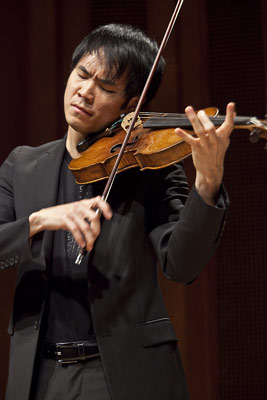Camerata Pacifica’s May Concert
Chamber Music Group Tackles Lesser-Known Beethoven, Clarke, Brahms
The final Camerata Pacifica concert of the 2008-’09 season brought together the principal players of the ensemble for an evening that was representative of what is strongest about the organization. Catherine Leonard, Adrian Spence, Ani Aznavoorian, Richard O’Neill, and Warren Jones have been playing together for several years now, and the group dynamic has coalesced into something more than the sum of its parts. There’s a musical conversation going on here, and while it digresses occasionally into the more obscure reaches of the 20th century, the main topic, which is the achievement of the classical repertoire as it tumbles over into Romanticism, persists.

On Friday night at Hahn Hall, the first item was an unusual Beethoven piece, the Serenade for Flute, Violin, and Viola in D Major, Op. 25. It’s a trebly, slightly jittery showcase, full of sensational effects. The flute flutters, the violin goes with it, and the viola performs some breathtaking double stops before it is through. Not the most representative piece of Beethoven chamber music, the serenade nevertheless reveals yet another intriguing side of the master craftsman. Spence broke off after a few bars of the group’s first attempt at the piece to have Hahn Hall’s acoustic curtains lowered halfway. The impact was striking, lending credibility to the claim that this magnificent space is delicate acoustically and can be as finely tuned as any of the musical instruments on its stage.
Rebecca Clarke was a virtuoso violist in the early 20th century who also happened to be a very talented composer. The Sonata for Viola and Piano from 1919 is her best-known work, and it made a wonderful showcase for O’Neill. The opening-“Impetuoso”-is certainly memorable, with its leaping intervals creating a feeling of urgency. The second theme is longer and more hypnotic, offering O’Neill and Jones the opportunity to sustain a different mood.
The Piano Quartet No. 2 in A Major, Op. 26 of Johannes Brahms, which followed the interval, is a titanic piece of chamber music, weighing in at a hefty 55 minutes. The writing throughout is sublime, and the playing was dazzling. This is Brahms at his most musically adventurous, providing the bridge that would connect the Vienna of Haydn, Mozart, and Schubert with that of the so-called Second Viennese School of Schnberg, Berg, and Webern. It’s glorious music, not in the least intellectual or off-putting, yet full of profundity. This is the kind of performance that makes this group so special, and it was an excellent cap to another outstanding season.



